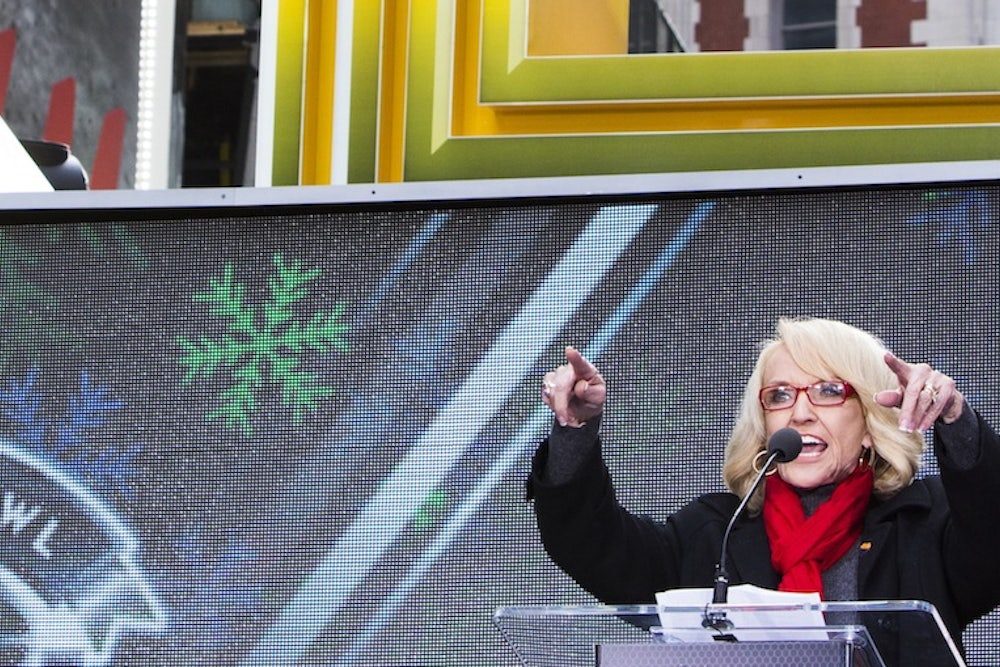It seems pretty clear that Jan Brewer’s decision to veto Arizona’s “religious freedom” bill on Wednesday was less about courage than political common sense. Among those urging Brewer to block the proposal were Arizona’s Republican delegation in Washington, the host committee for next year’s Super Bowl in Phoenix, and a number of prominent corporate leaders.
The campaign undoubtedly reflected some genuine moral outrage at what the bill would have done: allowing businesses to refuse service to LGBT clients. But it was also recognition of how significantly attitudes about homosexuality have changed in this country. Overt discrimination against gays is no longer acceptable in polite society, making these sorts of laws toxic to politicians and business leaders alike. As Alexander Burns and M.J. Lee observe in Politico, “What Arizona proved, as much as any other in recent American politics, is that there’s currently no more powerful constituency for gay rights than the Fortune 500 list.”
But that raises an interesting question: Why have attitudes changed? The transformation may seem inevitable now, but it didn’t always. And it’s happened with breathtaking speed. As my colleague Marc Tracy noted the other day, it was just ten years ago that President Bush and the Republicans unabashedly used the threat of gay marriage to whip conservative voters into a frenzy. Since that time, support for same-sex marriage has increased 21 percent, according to a just-released poll from the Public Religion Research Institute (PPRI). A majority now express support for same-sex marriage, up from about a third in 2003. Other polls show similar shifts.
It’s easy to assume the change represents nothing more than a generational shift. And, superficially, the survey data would seem to support that: In virtually every demographic category, support for same-sex marriage is higher among younger generations. But that’s not the whole story—not by a longshot. Pollsters have found that, over time, support for same-sex marriage has risen even within generations. “We estimated that support for marriage equality rose by 16 percentage points between 2004 and 2011, and that only one-quarter of it can be explained by cohort replacement,” says Gregory Lewis, a professor at Georgia State University, referring to report he co-authored for the group Third Way. “The remainder is people changing their minds.” (See the graph below, which comes from that report and shows how approval of same-sex marriage has risen over time, within each birth cohort.)

One likely reason for this, according to most social scientists, is the contact theory. As more people realize that they have a gay neighbor or friend or family member, the reality of that relationship crashes into—and destroys—their stereotypes and preconceptions. There’s some strong evidence of this effect. It’s the fact that people who say they have gay friends or family are more likely to express tolerant attitudes generally and acceptance of same-sex marriage specifically.
But even that explanation is inadequate. For one thing, there’s a possible selection bias in the polling data: The people most likely to hear that a friend or loved one is gay may be the ones most likely to take the news well. (Think about it: If you’re gay, the people you tend to tell will be the ones you expect to react positively.) In addition, all of those LGBT people didn’t magically appear out of thin air. They were there all along—only, they were in the closet, unable to talk about their sexual orientation. So the real mystery here, or at least a big part of it, is what suddenly made the environment more hospitable?
At this point, social scientists admit, they have no answers they can verify—only theories that seem roughly to fit the facts. And one of those theories is about popular culture. Cultural conservatives complain that Hollywood has foisted acceptance of homosexuality on the country. There's something to that. In movies and on television, through the worlds of music and art, performers and producers have aggressively challenged majority views about homosexuality—going at least back to 1997, and the release of In and Out, starring Kevin Kline as a small town schoolteacher who backs out of a marriage because he realizes he is gay.
The movie’s premise seems almost quaintly anachronistic at at time when openly gay characters are a Hollywood cliché. But the movie was a minor watershed of sorts. “By portraying people’s response to Howard’s and Peter’s coming out in a matter-of-fact and accepting way,” Steven Seidman observes in Beyond the Closet: The Transformation of Gay and Lesbian Life, “the film suggests that not only do gay people approach being gay as a normal identity but much of straight America does too.” Without such films and movies, it’s almost certain attitudes would not have changed as quickly.
But the pop culture explanation has limits, too. “LGBT presence on TV has been rising fairly steadily, as has support for same-sex marriage,” notes Lewis, who teaches at the Andrew Young School of Policy Studies, “but people who chose to watch ‘Will and Grace’ were systematically different from those who did not.” And that’s why, ultimately, a full explanation will have to account for individual actions—not from politicians and business leaders, but from the millions of Americans who identified themselves as gay during the years when it was a lot less acceptable than it is today. This may have created a critical mass, enabling many more people to talk about their sexual identity and, simultaneously, enabling them to have more serious conversations about it.
Of course, to identify as gay is still to take real risks—of ostracism, discrimination, even physical harm. But the risk is smaller than it once was, and that’s in no small part of those individuals who decided to be real trailblazers. It was their courage, as much as any politician's or business leader's, that made possible this week's victory in Arizona.
